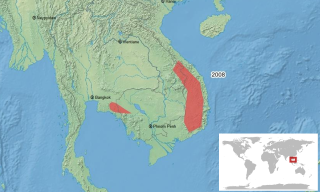
The Microhylidae, commonly known as narrow-mouthed frogs, are a geographically widespread family of frogs. The 683 species are in 63 genera and 11 subfamilies, which is the largest number of genera of any frog family.

Tomato frogs are any of the three species of genus Dyscophus : D. antongilii, D. insularis, or D. guineti. Dyscophus is the only genus in subfamily Dyscophinae. They are endemic to Madagascar

Cophixalus is a genus of microhylid frogs. These are arboreal species with expanded toe-pads, endemic to Moluccan Islands, New Guinea and northeastern Queensland, Australia.
Choerophryne gunnari is a species of frog in the family Microhylidae. It is endemic to Papua New Guinea and is known from the area of its type locality in the Central Province, and from the western slopes of Mount Obree, also in the Central Province.

Glyphoglossus is a genus of frogs in the family Microhylidae. The genus occurs in Southeastern Asia. Common name balloon frogs has been coined for it, whereas the common name squat frogs refers to the Calluella species that are now included in this genus. They are fossorial frogs that spend only limited time on the soil surface and are typically known from only few specimens.

The Annam chorus frog, also commonly known as the Annam narrow-mouthed frog, Vietnam rice frog or minute narrow-mouthed frog, is a species of frog in the family Microhylidae. It is found in Cambodia, Laos, Thailand, and Vietnam. Its natural habitats are subtropical or tropical moist lowland forests, subtropical or tropical moist montane forests, swamps, and intermittent freshwater marshes. It is listed as vulnerable by the IUCN Red List due to habitat loss and degradation.
The Larut Hills rice frog is a species of frog in the family Microhylidae. It is found in Peninsular Malaysia; records from Thailand and elsewhere probably refer to other species. Its natural habitats are evergreen submontane and montane rainforests. It lives on the forest floor and in puddles and breeds in temporary pools. It is locally threatened by habitat loss.
Nanohyla marmorata is a species of frog in the family Microhylidae. It is found in Laos and Vietnam. It is not considered threatened by the IUCN.
Nanohyla nanapollexa is a species of frog in the family Microhylidae also known as the no-thumb pigmy frog. It is endemic to Vietnam. Its natural habitats are subtropical or tropical moist montane forests and rivers. It is considered data deficient by the IUCN Red List.

Nanohyla petrigena is a species of frog in the family Microhylidae. It is found in northern and central Borneo and in the Sulu Archipelago of the Philippines. The common names pothole narrow-mouthed frog and Kapit rice frog have been coined for the species.
The spotted rubber frog is a species of frog in the family Microhylidae. It is found in Angola, Democratic Republic of the Congo, Namibia, Zambia, possibly Botswana, possibly Tanzania, and possibly Zimbabwe. Its natural habitats are dry savanna, moist savanna, subtropical or tropical dry shrubland, intermittent freshwater lakes, and intermittent freshwater marshes.
The marbled rubber frog is a species of frog in the family Microhylidae.

The banded rubber frog is a species of frog in the family Microhylidae. It is found in central and southern Africa. Its natural habitats are dry savanna, moist savanna, subtropical or tropical dry shrubland, subtropical or tropical moist shrubland, subtropical or tropical dry lowland grassland, subtropical or tropical seasonally wet or flooded lowland grassland, subtropical or tropical high-altitude grassland, intermittent freshwater lakes, intermittent freshwater marshes, arable land, pastureland, water storage areas, ponds, and canals and ditches. The female can reach a maximum size of 65 mm whereas the tadpoles can reach a size of 37 mm. The maximum size of the male is yet unknown, but sizes differ from 45 mm to 68 mm.

Phrynomantis microps, the Accra snake-necked frog, red rubber frog or West African rubber frog, is a species of frog in the family Microhylidae. It is found in central and western sub-Saharan Africa. Phrynomantis microps is a medium-sized frog with an elongated and depressed body.
Phrynomantis somalicus, also known as Somali rubber frog or Somali snake-necked frog, is a species of frog in the family Microhylidae. It is known from southern Ethiopia and southern Somalia. Its total distribution is poorly known and might extend into Kenya.
The marbled frog is a species of ground-dwelling frog in the family Myobatrachidae native to northern and north-eastern Australia, and southern New Guinea.
Banded frog may refer to:








